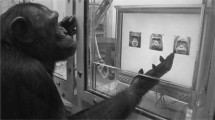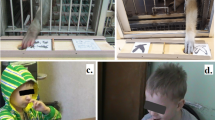Abstract
The extent to which categorization of natural classes in animals reflects a generalization based on perceptual similarity versus an abstract conceptual representation remains unclear. Here, two experiments were conducted to identify the perceptual features used by orangutans when categorizing pictures. In Experiment 1, subjects were trained and tested for transfer on a concrete discrimination (gorillas or orangutans vs. other primates). Analysis of performance on both positive and negative exemplars revealed that performance was best on photos with faces, particularly close-ups. Moreover, error trials did not seem to reflect instances of mistaken identity, but rather, exemplars that may have been distracting for other reasons, such as novel coloration or morphology. In Experiment 2, photos were modified to test the effects of various features. Color modifications caused the biggest decrease in performance, and eye modifications also affected performance deleteriously. Therefore, two perceptual features, namely eye regions and color, played a key role in subjects’ ability to categorize. However, performance based on an underlying concept cannot be ruled out, because both of these features are highly relevant in terms of defining category membership. Although a subset of features was identified as playing a key role in categorization, these features differed depending on whether feature-use was studied indirectly, as in Experiment 1, or directly, as in Experiment 2.




Similar content being viewed by others
References
Astley SL, Wasserman EA (1999) Superordinate category formation in pigeons: association with a common delay or probability of food reinforcement makes perceptually dissimilar stimuli functionally equivalent. J Exp Psychol Anim Behav Process 25:415–432
Bhatt RS, Wasserman EA, Reynolds WF, Knauss KS (1988) Conceptual behaviour in pigeons: categorization of both familiar and novel examples from four classes of natural and artificial stimuli. J Exp Psychol Anim Behav Process 14:219–234
Brown DA, Boysen ST (2000) Spontaneous discrimination of natural stimuli by chimpanzees (Pan troglodytes). J Comp Psychol 114:392–400
Delorme A, Richard G, Fabre-Thorpe M (2000) Ultra-rapid categorisation of natural scenes does not rely on colour cues: a study in monkeys and humans. Vision Res 40:2187–2200
D’Amato MR, Van Sant P (1988) The person concept in monkeys (Cebus paella). J Exp Psychol Anim Behav Process 14:43–55
Eimas PD, Quinn PC (1994) Studies on the formation of perceptually based basic-level categories in young infants. Child Dev 65:903–917
Ghosh N, Lea SEG, Noury M (2004) Transfer to intermediate forms following concept discrimination by pigeons: chimeras and morphs. J Exp Anal Behav 82:125–141
Gibson BM, Wasserman EA, Gosselin F, Schyns PG (2005) Applying bubbles to localize features that control pigeons’ visual discrimination behaviour. J Exp Psychol Anim Behav Process 31:376–382
Gosselin F, Schyns PG (2001) Bubbles: a technique to reveal the use of information in recognition tasks. Vision Res 41:2261–2271
Greene SL (1983) Feature memorization in pigeon concept formation. In: Commons ML, Herrnstein RJ, Wagner AR (eds) Quantitative analyses of behavior: discrimination processes. Ballinger, Cambridge, pp 209–229
Herrnstein RJ, de Villiers PA (1980) Fish as a natural category for people and pigeons. In: Bower GH (ed) The psychology of learning and motivation, vol 14. Academic Press, New York, pp 59–95
Herrnstein RJ, Loveland DH (1964) Complex visual concept in the pigeon. Science 146:549–551
Herrnstein RJ, Loveland DH, Cable C (1976) Natural concepts in pigeons. J Exp Psychol Anim Behav Process 2:285–302
Huber L, Troje NF, Loidolt M, Aust U, Grass D (2000) Natural categorization through multiple feature learning in pigeons. Q J Exp Psychol 4:341–357
Jitsumori M (1993) Category discrimination of artificial polymorphous stimuli based on feature learning. J Exp Psychol Anim Behav Process 19:244–254
Jitsumori M, Matsuzawa T (1991) Picture perception in monkeys and pigeons: transfer of rightside-up versus upside-down discrimination of photographic objects across conceptual categories. Primates 32:473–482
Jitsumori M, Yoshihara M (1997) Categorical discrimination of human facial expressions by pigeons: a test of the linear feature model. Q J Exp Psychol 3:253–268
Jitsumori M, Delius JD (2001) Object recognition and object categorization in animals. In: Matsuzawa T (ed) Primate origins of human cognition and behaviour. Springer, New York, pp 269–92
Kyes RC, Candland DK (1987) Baboon (Papio hamadryas) visual preferences for regions of the face. J Comp Psychol 101:345–348
Lea SEG, Harrison SN (1978) Discrimination of polymorphous stimulus sets by pigeons. Q J Exp Psychol 30:521–537
Martin-Malivel J, Fagot J (2001) Perception of pictorial human faces by baboons: effects of stimulus orientation on discrimination performance. Anim Learn Behav 29:10–20
Martin-Malivel J, Mangini MC, Fagot J, Biederman I (2006) Do humans and baboons use the same information when categorizing human and baboon faces? Psychol Sci 17:599–607
Parr LA, de Waal (1999) Visual kin recognition in chimpanzees. Nature 399:647–648
Parr LA, Winslow JT, Hopkins WD, de Waal FBM (2000) Recognizing facial cues: Individual discrimination by chimpanzees (Pan troglodytes) and rhesus monkeys (Macaca mulatta). J Comp Psychol 114:47–60
Quinn PC, Eimas PM (1996) Perceptual cues that permit categorical differentiation of animal species by infants. J Exp Child Psychol 63:189–211
Roberts WA, Mazmanian DS (1988) Concept learning at different levels of abstraction by pigeons, monkeys, and people. J Exp Psychol Anim Behav Process 14:247–260
Ryan CM (1982) Concept formation and individual recognition in the domestic chicken (Gallus gallus). Behav Anal Lett 2:213–220
Schrier AM, Angarella R, Povar ML (1984) Studies of concept formation by stumptailed monkeys: concepts humans, monkeys, and letter A. J Exp Psychol Anim Behav Process 10:564–584
Schrier AM, Brady PM (1987) Categorization of natural stimuli by monkeys (Macaca mulatta): effects of stimulus set size and modification of exemplars. J Exp Psychol Anim Behav Process 13:136–143
Spencer J, Quinn PC, Johnson MH, Karmiloff-Smith A (1997) Heads you win, tails you lose: Evidence for young infants categorizing mammals by head and facial attributes. Early Dev Parent 6:113–126
Tanaka M (2001) Discrimination and categorization of photographs of natural objects by chimpanzees (Pan troglodytes). Anim Cogn 4:201–211
Vogels R (1999) Categorization of complex visual images by rhesus monkeys. Part 1: behavioural study. Eur J Neurosci 11:1223–1238
Vokey JR, Rendall D, Tangen JM, Parr LA, de Waal FBM (2004) Visual kin recognition and family resemblance in chimpanzees (Pan troglodytes). J Comp Psychol 118:194–199
Vonk J, MacDonald SE (2002) Natural concepts in a juvenile gorilla (Gorilla, gorilla gorilla) at three levels of abstraction. J Exp Anal Behav 78:315–329
Vonk J, MacDonald SE (2004) Levels of abstraction in orangutan (Pongo abelli) categorization. J Comp Psychol 118:3–13
Wasserman EA, Kiedinger RE, Bhatt RS (1988) Conceptual behaviour in pigeons: Categories, subcategories, and pseudocategories. J Exp Psychol Anim Behav Process 14:235–246
Acknowledgments
The authors wish to thank the staff of the Indo-Malayan Pavillion at the Toronto Zoo, in particular, Bridget Burke-Johnson, Jackie Craig, and Bev Carter, for their continued assistance and cooperation. The authors also thank Andrew Marsh for his assistance with apparatus construction and computer programming. The experiments conducted comply with the current laws and ethical guidelines of Canada.
Author information
Authors and Affiliations
Corresponding author
Electronic supplementary material
Below is the link to the electronic supplementary material.
Rights and permissions
About this article
Cite this article
Marsh, H.L., MacDonald, S.E. The use of perceptual features in categorization by orangutans (Pongo abelli). Anim Cogn 11, 569–585 (2008). https://doi.org/10.1007/s10071-008-0148-1
Received:
Revised:
Accepted:
Published:
Issue Date:
DOI: https://doi.org/10.1007/s10071-008-0148-1




